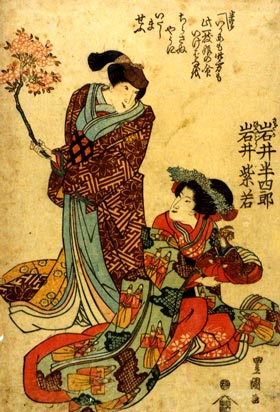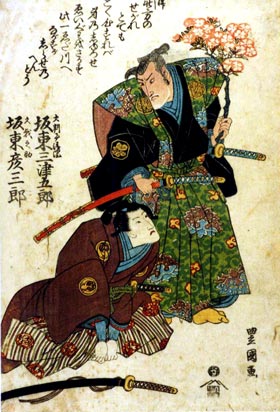| YOSHINOGAWA |
| Play title | Imoseyama Onna Teikin Mt Imo and Mt Se: A Tale of Womanly Virtue |
| Authors | Chikamatsu Hanji Miyoshi Shôraku Matsuda Boku Eizenbei Chikamatsu Tônan |
| History |
The play "Imoseyama Onna Teikin" was originally written for the puppet theater (Bunraku) and staged for the first time in the 1st lunar month of 1771 in Ôsaka at Takeda Shinmatsu's theater (ex-Takemotoza). It was quickly adapted for Kabuki and staged in Kyôto in the 3rd lunar month of 1771 at the Kitagawa no Shibai [casting]. It was a long run, produced from the 25th day of the 3rd lunar month to the 10th of the 5th lunar month of 1771. This play is based on the Taika coup d'etat in 645, in which Emperor Tenchi, with his loyal minister Fujiwara no Kamatari, succeeded in destroying the wicked Soga no Iruka. |
| Structure |
"Yoshinogawa" is the third, main and last scene (kiri) of the third act of the drama "Imoseyama Onna Teikin". |
| Key words |
Asuka Jidai Fujiwara Kamatari Gidayû Kyôgen Imoseyama Jidaimono Kari-hanamichi Kii Kiri Ôchômono Ôdaimono Soga Iruka Taika no Kaishin Yamato Yoshinogawa |
| Summary |
"Yoshinogawa" is a Romeo and Juliet-type story about the lovers Koganosuke and Hinadori, the handsome son of Daihanji no Kiyozumi and the beautiful daughter of the widow Sadaka, whose parents have been feuding over the boundary between their territories. The stage set is both unique and gorgeous. It is the only Kabuki play in which two hanamichi runways are used. Each one leads to the main stage, which has a river flowing down the center, flanked by cherry trees in full bloom. On either side of the river are the houses of the two clans. To the left is the home of the widow Sadaka and her daughter Hinadori, in which the walls are painted cream, the doors gold, and a vivid red Dolls' Festival display dominates the living room. To the right is the mansion of Daihanji and his son Koganosuke. Here the walls are a rich brown, and silver screens adorn the main room. Cherry blossoms hang from above the stage and are painted on the wings of the set, creating a frame of pink around the stage. As the scene opens, the two young people are in their respective homes: Koganosuke is reading Buddhist scriptures alone in his father's house at the foot of Mount Seyama in Kii Province (Wakayama Prefecture), Hinadori is celebrating the Doll Festival with her attendants in her mother's house at the foot of Mount Imoyama in Yamato Province. They are pining for each other, but are separated by the Yoshino River painted in bright blue and white, which appears to be flowing out from the back of the stage toward the audience by the use of a stage device called takiguruma (waterfall wheels). Daihanji and Sadaka appear on stage and greet each other courteously. The pair are suspected by Iruka of hiding Lady Uneme, the emperor's consort, whom Iruka wants to marry because she is the daughter of his political enemy Kamatari. Daihanji has been pondering having Koganosuke commit seppuku in order to avert Iruka's suspicion, as the young man helped Lady Uneme go into hiding. Sadaka, ordered by Iruka to give him her daughter Hinadori to be his mistress, has considered killing Hinadori and presenting her head to Iruka. When Sadaka hears that Hinadori would indeed prefer to die rather than go to Iruka, she beheads her daughter with a single stroke and sends the severed head, in a miniature palanquin, across the river to be united with Koganosuke, who has just stabbed himself. Seeing his dying son cradle Hinadori's head, Daihanji administers him the final, decapitating blow. The 2nd paragraph is courtesy of Jean Wilson (1999) |
 |
 |
|
The actors Iwai Hanshirô V and Iwai Shijaku I playing the roles of Sadaka and Hinadori in the "Yoshinogawa" scene of "Imoseyama Onna Teikin", which was staged in the 8th lunar month of 1824 at the Ichimuraza |
The actors Bandô Mitsugorô III (right) and Bandô Hikosaburô IV playing the roles of Daihanji and Koganosuke in the "Yoshinogawa" scene of "Imoseyama Onna Teikin", which was staged in the 8th lunar month of 1824 at the Ichimuraza |
|
|
| Contact | Main | Top | Updates | Actors | Plays | Playwrights | Programs | Links | FAQ | Glossary | Chronology | Illustrations | Prints | Characters | Derivatives | Theaters | Coming soon | News |